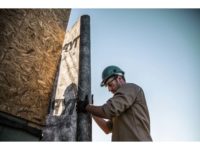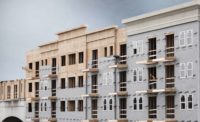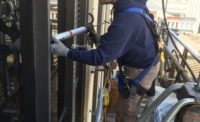Finding Harmony Between Waterproofing and Breathability






With as many ways as there are to construct a wall system, there are an equal number of ways to try to keep that wall dry. But as we race to waterproof our wall assemblies, we may be inadvertently making it easier for moisture-related issues to fester. After all, no matter how tightly we construct our buildings, water is inevitably going to find its way in. There’s no such thing as a “waterproof” wall.
What we can affect is how to properly manage moisture within a wall cavity. The walls that will last the longest are the ones that have been designed to realistically manage moisture and dry out, not those designed to achieve the unachievable goal of completely locking out all moisture. Choices for managing moisture are expanding, driven by advances in technology, evolving building codes, and a growing customer concern with mold prevention, indoor air quality and energy efficiency—among many other factors.
Reaching Optimal Breathability
Water can enter into a wall in numerous ways. High humidity and extreme temperatures can cause vapor diffusion when warm indoor air causes condensation on colder outside surfaces. Wind-driven rain can be forced into small openings in the exterior cladding at joints, laps and utility cutouts. Wind blowing around the building can create a negative pressure within the wall assembly which siphons water into the wall.
One of the most challenging situations in which to manage moisture is when there is a reservoir cladding, like brick or stucco, combined with a climate that requires indoor air conditioning. A brick or stucco cladding will absorb and store moisture, which is released both inward and outward when warmed by the sun. Where that moisture goes—and how quickly it gets there—is largely determined by the permeability of the building materials used in the assembly.
In most cases, the outwardly driven moisture won’t cause many problems (unless you’re dealing with a material like stucco that’s been painted with a low-perm paint, in which vase you would see bubbling and cracking). It’s the inwardly driven moisture that presents the most pressing challenge.
Typically, this outwardly driven moisture vapor is managed by separating the cladding from the rest of the assembly with a capillary break, which can be an airspace or a material that sheds water or does not absorb or pass water. Materials such as building wraps are adapting to meet this need (more on this later).
But in situations where a reservoir cladding like brick is paired with a highly permeable sheathing like gypsum board, which can be as much as 50 perms, an air space may not be enough to slow down inward moisture intrusion. In these applications, an added water-resistive barrier (WRB) is needed to reduce unwanted moisture intrusion.
In the recent paper, “Inward Drive – Outward Drying,” building scientist Joseph Lstiburek identifies the “sweet spot” for the permeance of this WRB layer as between 10 and 20 perms. Too high, he writes, and the moisture driven out of the back side of the reservoir cladding into the air space will blow through the layer, through the permeable sheathing and into the wall cavity. Too low, and the outward drying potential of the cavity is compromised.
Thankfully, building wrap technology has advanced to meet this need perfectly.
The Latest in Building Wrap Technology
Due to their durability and ease of installation, building wraps made of polyethylene or polypropylene fabric have been a popular method of protecting against moisture intrusion since the 1970s. But as building assemblies have gotten tighter, building wraps have taken on a new function—helping to remove trapped water from the building enclosure. Their unique functionality enables them to both block moisture from the outside while also allowing walls to “breathe” to prevent vapor buildup. And the very latest innovations in housewrap technology is taking this moisture removal function one step further to incorporate drainage capabilities, as well.
The International Code Council Evaluation Service (ICC-ES) evaluates the following key performance characteristics for housewrap products, which provide a valuable starting point for deciding which product is right for your project.
Water Resistance
As its most basic function, a housewrap must hold out liquid water. A premium housewrap will be able to pass both “water ponding” tests, which measures a housewrap’s resistance to a pond of 1-inch water over two hours, and a more stringent hydrostatic pressure test where the wrap is subjected to a pressurized column of water for five hours.
Durability
The ICC-ES looks at the tear resistance and tensile strength as the best measure of a housewrap’s durability, since it must be able to withstand the handling and application process without losing any of its water resistance. UV and low temperature resistance are also important measures of durability because prolonged exposure to the elements can compromise the integrity of the product or cause it to crack.
Vapor Permeability
Permeability measures the amount of vapor transmission that a building wrap will allow over a period of time. For a product to be considered a building wrap and not a vapor retarder, ICC-ES mandates the permeance rating must be higher than 5 perms. But there are a variety of ways permeability is achieved, and as noted by Mr. Lstiburek, a higher perm rating doesn’t always equal a better housewrap.
When selecting a building wrap, you’ll want to aim for that “sweet spot” of 10-20 perms to achieve the desired balance of moisture protection and breathability. For example, some wraps have mechanical perforations, which may allow the passage of more water vapor, but could also be more vulnerable to bulk water leakage. Generally, it’s better to go with a higher quality, non-perforated or micro-porous product, which allows for sufficient vapor mitigation while providing excellent resistance to bulk water.
Drainage
Drainage is widely accepted as one of the most effective measures for reducing moisture damage due to rain penetration. Drainage is a critical component in allowing a building wrap to do its job, particularly in keeping walls dry. There are methods to enhance the drainage plane. Usually this involves the use of furring strips that separate the wrap from the structural sheathing and framing, but new technologies have emerged that are helping to simplify this process.
At the cutting edge of today’s housewrap technologies are new products that integrate drainage gaps into the material itself through creping, embossing, weaving, or filament spacers. These new products eliminate the need for furring strips, helping to reduce material costs and streamline installation.
These new drainable housewraps meet all current code requirements for drainage efficiency (ASTM E2273) without sacrificing any of the durability and ease of installation benefits builders and contractors have come to expect from premium housewraps, since they essentially handle and install the same. They are also vapor permeable, so moisture will not become trapped in the wall assembly and lead to mold or rot issues.
Other Considerations
With so many options to choose from, how do you know what type of weather protection is best for your project? Outside of the aforementioned performance metrics, there are a number of other factors to consider.
Cladding
In addition to the challenges associated with reservoir claddings, other types of cladding require careful consideration when it comes to managing moisture. For example, tightly fastened cladding such as cedar siding or fiber cement board might allow water trapped between the siding and a smooth housewrap to pool and could eventually make its way through the housewrap and into the framing. These are cases where a drainable housewrap would provide significant benefit.
Surfactant Resistance
Common cladding materials often contain chemicals called surfactants (or surface active agents) that can affect the water resistance of housewrap. These chemicals, which are also present in solutions used to power wash siding, reduce the surface tension of water, easing its ability to pass through microscopic openings in the membrane. So if the building wrap will be exposed to surfactants, be sure to choose a product that has added protection against their harmful effects.
Geography and Climate
As a rule of thumb, the Building Enclosure Moisture Management Institute recommends that any area receiving more than 20 inches of annual rainfall should incorporate enhanced drainage techniques in the wall system, especially if using an absorptive cladding material, while areas receiving 40 inches or more should utilize rainscreen design regardless of cladding material. The geographic orientation of the wall, amount of overhang, altitude, and even nearby trees can also have an impact on how much water intrusion can be expected and how likely it is to dry.
In many places, new and evolving building codes are driving the need for better moisture management solutions. The International Residential Code (IRC) requires the use of WRBs, but some areas have added even more prescriptive measures to their codes that now include the use of drainage planes, and others are expected to follow.
Compatibility of Materials
Compatibility of materials should also be taken into serious consideration. Sealants with high solvent or plasticizer content for example, can damage bitumen flashing products causing functional and aesthetic issues. To counter this problem some manufacturers have developed a system approach that includes compatible tapes for seaming and adhesive flashings for openings. A compatible, properly installed system vastly improves air and moisture resistance.
Craftsmanship is Key
No matter how many benefits it offers, a building wrap must be properly installed in order to do its job. Housewrap should be installed from the foundation upward, making sure to overlap joints with the higher course overlapping the lower. Code mandates that all horizontal seams overlap a minimum of 2 inches, and vertical seams at least 6 inches. Keep in mind that horizontal laps are just as important as vertical laps because windblown rain can travel sideways, or even up and over a properly installed lap. Manufacturer-recommended tape should be used to cover any tears and holes, and galvanized roofing nails or plastic cap nails should be used to attach the housewrap to the structural sheathing and framing.
Advances in technology and building codes are driving adoption of better moisture management systems, and that’s a great thing. The building industry is also starting to realize that the race toward a “waterproof” wall assembly is a fantasy, and is now looking for smarter strategies for managing unwanted moisture and helping walls to dry when they inevitably get wet.
Thankfully, today’s advanced building wrap products offer a powerful new defense against the elements by adding drainage capabilities to a solid mix of water resistance, durability and breathability.
Looking for a reprint of this article?
From high-res PDFs to custom plaques, order your copy today!








